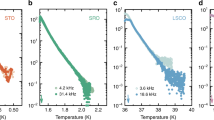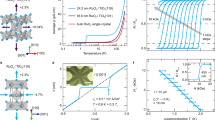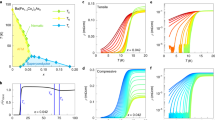Abstract
The properties of quantum materials are commonly tuned using experimental variables such as pressure, magnetic field and doping. Here we explore a different approach using irreversible, plastic deformation of single crystals. We show that compressive plastic deformation induces low-dimensional superconductivity well above the superconducting transition temperature (Tc) of undeformed SrTiO3, with evidence of possible superconducting correlations at temperatures two orders of magnitude above the bulk Tc. The enhanced superconductivity is correlated with the appearance of self-organized dislocation structures, as revealed by diffuse neutron and X-ray scattering. We also observe deformation-induced signatures of quantum-critical ferroelectric fluctuations and inhomogeneous ferroelectric order using Raman scattering. Our results suggest that strain surrounding the self-organized dislocation structures induces local ferroelectricity and quantum-critical dynamics that strongly influence Tc, consistent with a theory of superconductivity enhanced by soft polar fluctuations. Our results demonstrate the potential of plastic deformation and dislocation engineering for the manipulation of electronic properties of quantum materials.
This is a preview of subscription content, access via your institution
Access options
Access Nature and 54 other Nature Portfolio journals
Get Nature+, our best-value online-access subscription
$29.99 / 30 days
cancel any time
Subscribe to this journal
Receive 12 print issues and online access
$259.00 per year
only $21.58 per issue
Buy this article
- Purchase on Springer Link
- Instant access to full article PDF
Prices may be subject to local taxes which are calculated during checkout






Similar content being viewed by others
Data availability
All data and materials are available from the corresponding authors upon request.
Code availability
All computer codes used to generate the results presented in the paper are available from the corresponding authors upon request.
References
Pfeiffer, E. R. & Schooley, J. F. Effect of stress on the superconductive transition temperature of strontium titanate. Phys. Rev. Lett. 19, 783–785 (1967).
Chu, J.-H. et al. In-plane resistivity anisotropy in an underdoped iron arsenide superconductor. Science 329, 824–826 (2010).
Steppke, A. et al. Strong peak in Tc of Sr2RuO4 under uniaxial pressure. Science 335, eaaf9398 (2017).
Herrera, C. et al. Strain-engineered interaction of quantum polar and superconducting phases. Phys. Rev. Mater. 3, 124801 (2019).
Jakobsen, B. et al. Formation and subdivision of deformation structures during plastic deformation. Science 321, 889–892 (2006).
Sugiyama, I. et al. Ferromagnetic dislocations in antiferromagnetic NiO. Nat. Nanotech. 8, 266–270 (2013).
Shimada, T., Xu, T., Araki, Y., Wang, J. & Kitamura, T. Multiferroic dislocations in ferroelectric PbTiO3. Nano Lett. 17, 2674–2680 (2017).
Kolhatkar, G. et al. Second harmonic generation investigation of symmetry breaking and flexoelectricity induced by nanoindentations in SrTiO3. Adv. Funct. Mater. 29, 1901266 (2019).
Willa, R., Hecker, M., Fernandes, R. M. & Schmalian, J. Inhomogeneous time-reversal symmetry breaking in Sr2RuO4. Phys. Rev. B 104, 024511 (2021).
Masuda, K., Lich, L. V., Shimada, T. & Kitamura, T. Periodically-arrayed ferroelectric nanostructures induced by dislocation structures in strontium titanate. Phys. Chem. Chem. Phys. 21, 22756–22762 (2019).
Schooley, J. F., Hosler, W. R. & Cohen, M. L. Superconductivity in semiconducting SrTiO3. Phys. Rev. Lett. 12, 474–475 (1964).
Collignon, C., Lin, X., Rischau, C. W., Fauqué, B. & Behnia, K. Metallicity and superconductivity in doped strontium titanate. Annu. Rev. Cond. Matt. Phys. 10, 25–44 (2019).
Gastiasoro, M. N., Ruhman, J. & Fernandes, R. Superconductivity in dilute SrTiO3: a review. Ann. Phys. 417, 168107 (2020).
Swartz, A. G. et al. Polaronic behaviour in a weak-coupling superconductor. Proc. Natl Acad. Sci. USA 115, 1475–1480 (2018).
Cava, R. J. Oxide superconductors. J. Am. Ceram. Soc. 83, 5–28 (2000).
Gumbsch, P., Taeri-Baghbadrani, S., Brunner, D., Sigle, W. & Rühle, M. Plasticity and inverse brittle-to-ductile transition in strontium titanate. Phys. Rev. Lett. 87, 085505 (2001).
Hirel, P., Carrez, P. & Cordier, P. From glissile to sessile: effect of temperature on <110> dislocations in perovskite materials. Scr. Mater. 120, 67–70 (2016).
Gay, P. & Honeycombe, R. W. K. X-ray asterisms from deformed crystals. Proc. Phys. Soc. A 64, 844–845 (1951).
Lewis, D. X-ray microbeam study of deformation bands in aluminium. Br. J. Appl. Phys. 11, 162–164 (1960).
Barabash, R. I. & Klimanek, P. X-ray scattering by crystals with local lattice rotation fields. J. Appl. Crystallogr. 32, 1050–1059 (1999).
Cowley, R. A. The phase transition of strontium titanate. Philos. Trans. R. Soc. Lond. A 354, 2799–2814 (1996).
Burke, W. J. & Pressley, R. J. Stress induced ferroelectricity in SrTiO3. Solid State Commun. 9, 191 (1971).
Coak, M. J., Haines, C. R. S., Liu, C., Guzmán-Verri, G. G. & Saxena, S. S. Pressure dependence of ferroelectric quantum critical fluctuations. Phys. Rev. B 100, 214111 (2019).
Gao, P. et al. Atomic-scale measurement of flexoelectric polarization at SrTiO3 dislocations. Phys. Rev. Lett. 120, 267601 (2018).
Gallais, Y. et al. Observation of incipient charge nematicity in Ba(Fe1−xCox)2As2. Phys. Rev. Lett. 111, 267001 (2013).
Van Mechelen, J. L. M. et al. Electron–phonon interaction and charge carrier mass enhancement in SrTiO3. Phys. Rev. Lett. 100, 226403 (2008).
Lin, X. et al. Critical doping for onset of two-band superconductivity in SrTiO3−δ. Phys. Rev. Lett. 112, 207002 (2014).
Ayino, Y., Yue, J., Wang, T., Jalan, B. & Pribiag, V. S. Evidence for multi-band superconductivity above the Pauli limit in NdxSr1−xTiO3. Preprint at https://arxiv.org/abs/1812.02875 (2018).
Liu, C. et al. Two-dimensional superconductivity and anisotropic transport at KTaO3 (111) interfaces. Science 371, 716–721 (2021).
Vagli, R., Attanasio, C., Maritato, L. & Ruosi, A. Explanation of the resistance-peak anomaly in nonhomogeneous superconductors. Phys. Rev. B 47, 15302–15303 (1993).
Lin, X., Fauqué, B. & Behnia, K. Scalable T2 resistivity in a small single-component Fermi surface. Science 349, 945–948 (2015).
Spinelli, A., Torija, M. A., Liu, C., Jan, C. & Leighton, C. Electronic transport in doped SrTiO3: conduction mechanisms and potential applications. Phys. Rev. B 81, 155110 (2010).
Coey, J. M. D., Venkatesan, M. & Stamenov, P. J. Surface magnetism of strontium titanate. J. Phys. Condens. Matter 28, 485001 (2016).
Aird, A. & Salje, E. K. H. Sheet superconductivity in twin walls: experimental evidence of WO3−x. J. Phys. Condens. Matter 10, L377–L380 (1998).
Lin, Y.-H., Chen, Y. & Goldman, A. M. Indications of superconductivity at somewhat elevated temperatures in strontium titanate subjected to high electric fields. Phys. Rev. B 82, 172507 (2010).
Uwe, H. & Sakudo, T. Stress-induced ferroelectricity and soft phonon modes in SrTiO3. Phys. Rev. B 13, 271–286 (1976).
Rowley, S. et al. Superconductivity in the vicinity of a ferroelectric quantum phase transition. Preprint at https://arxiv.org/abs/1801.08121 (2018).
Edge, J. M., Kedem, Y., Aschauer, U., Spaldin, N. A. & Balatsky, A. V. Quantum critical origin of the superconducting dome in SrTiO3. Phys. Rev. Lett. 115, 247002 (2015).
Kozii, V., Bi, Z. & Ruhman, J. Superconductivity near a ferroelectric quantum critical point in ultralow-density Dirac materials. Phys. Rev. X 9, 031046 (2019).
Gastiasoro, M. N., Trevisan, T. V. & Fernandes, R. M. Anisotropic superconductivity mediated by ferroelectric fluctuations in cubic systems with spin–orbit coupling. Phys. Rev. B 101, 174501 (2020).
van der Marel, D., Barantani, F. & Rischau, C. W. Possible mechanism for superconductivity in doped SrTiO3. Phys. Rev. Res. 1, 013003 (2019).
Ahadi, K. et al. Enhancing superconductivity in SrTiO3 films with strain. Sci. Adv. 5, eaaw0120 (2019).
Dunnett, K., Narayan, A., Spaldin, N. A. & Balatsky, A. V. Strain and ferroelectric soft mode induced superconductivity in strontium titanate. Phys. Rev. B 97, 144506 (2018).
Pelc, D., Anderson, Z., Yu, B., Leighton, C. & Greven, M. Universal superconducting precursor in three classes of unconventional superconductors. Nat. Commun. 10, 2729 (2019).
Pai, Y.-Y. et al. One-dimensional nature of superconductivity at the LaAlO3/SrTiO3 interface. Phys. Rev. Lett. 120, 147001 (2018).
McCalla, E., Gastiasoro, M. N., Cassuto, G., Fernandes, R. M. & Leighton, C. Low-temperature specific heat of doped SrTiO3: doping dependence of the effective mass and Kadowaki–Woods scaling violation. Phys. Rev. Mater. 3, 022001(R) (2019).
Jiang, M. P. et al. The origin of incipient ferroelectricity in lead telluride. Nat. Commun. 7, 12291 (2016).
Aktas, O., Crossley, S., Carpenter, M. A. & Salje, E. K. H. Polar correlations and defect-induced ferroelectricity in cryogenic KTaO3. Phys. Rev. B 90, 165309 (2014).
Sleight, A. W. Bismuthates: BaBiO3 and related superconducting phases. Phys. C. 514, 152–165 (2015).
Schilling, J. S., in Handbook of High-temperature Superconductivity (eds Schrieffer, J. R. & Brooks, J. S.) 427–457 (Springer, 2007).
Ye, F., Liu, Y., Whitfield, R., Osborn, R. & Rosenkranz, S. Implementation of cross correlation for energy discrimination on the time-of-flight spectrometer CORELLI. J. Appl. Crystallogr. 51, 315–322 (2018).
Michels-Clark, T. M., Savici, A. T., Lynch, V. E., Wang, X. & Hoffmann, C. M. Expanding Lorentz and spectrum corrections to large volumes of reciprocal space for single-crystal time-of-flight neutron diffraction. J. Appl. Crystallogr. 49, 497–506 (2016).
Krogstad, M. J. et al. Reciprocal space imaging of ionic correlations in intercalation compounds. Nat. Mater. 19, 63–68 (2020).
Drobac, Đ., Marohnić, Ž., Živković, I. & Prester, M. The role of lock-in phase setting in ac susceptibility measurements. Rev. Sci. Instrum. 84, 054708 (2013).
Landau, L. D. & Lifshitz, E. M. Theory of Elasticity (Butterworth-Heinemann, 1986).
Acknowledgements
We thank L.J. Thompson and Z. Jiang for help with sample preparation, S.L. Griffitt and A. Najev for assistance with the design and manufacturing of polishing rigs, C.N. Irfan Habeeb for help with figures, D. Robinson and S. Rosenkranz for assistance with X-ray scattering experiments, and B.I. Shklovskii, Y. Ayino, V. Pribiag, B. Kalisky and J. Ruhman for discussions and comments. The work at the University of Minnesota was funded by the US Department of Energy through the University of Minnesota Center for Quantum Materials, under grant number DE-SC-0016371. The work at Argonne was supported by the US Department of Energy, Office of Science, Basic Energy Sciences, Materials Sciences and Engineering Division. A portion of this research used resources at the Spallation Neutron Source, a DOE Office of Science User Facility operated by the Oak Ridge National Laboratory. This research used resources of the Advanced Photon Source, a US Department of Energy (DOE) Office of Science User Facility operated for the DOE Office of Science by Argonne National Laboratory under contract number DE-AC02-06CH11357. D.P. acknowledges support from the Croatian Science Foundation through grant number UIP-2020-02-9494. The work at Peking University was funded by the National Natural Science Foundation of China, under grant number 11874069. Sputtering and contacting of samples was conducted in the Minnesota Nano Center, which is supported by the National Science Foundation through the National Nano Coordinated Infrastructure Network, award number NNCI-1542202.
Author information
Authors and Affiliations
Contributions
D.P. and M.G. conceived the research. S.H., R.J.S., D.P., B.D. and J.R. performed transport and susceptibility measurements. S.H., Z.W.A., D.P. and Y. Liu. performed neutron scattering experiments and analysed data. Z.W.A., R.J.S., D.P., M.J.K. and R.O. performed X-ray scattering experiments and analysed data. L.Y. and Y. Li. performed Raman scattering experiments. S.H., L.Y., D.P. and Y. Li. analysed Raman data. A.K. and R.M.F. performed calculations. C.L. provided and characterized samples. C.L. and D.P oversaw transport measurements by S.H., B.D. and J.R. M.L. and D.P. designed and manufactured the pressure cells. D.P., A.K. and M.G. wrote the paper, with input from all authors.
Corresponding authors
Ethics declarations
Competing interests
The authors declare no competing interests.
Additional information
Peer review information Nature Materials thanks Benoit Fauqué and the other, anonymous, reviewer(s) for their contribution to the peer review of this work.
Publisher’s note Springer Nature remains neutral with regard to jurisdictional claims in published maps and institutional affiliations.
Supplementary information
Supplementary Information
Supplementary Figs. 1–13, discussion and references.
Rights and permissions
About this article
Cite this article
Hameed, S., Pelc, D., Anderson, Z.W. et al. Enhanced superconductivity and ferroelectric quantum criticality in plastically deformed strontium titanate. Nat. Mater. 21, 54–61 (2022). https://doi.org/10.1038/s41563-021-01102-3
Received:
Accepted:
Published:
Issue Date:
DOI: https://doi.org/10.1038/s41563-021-01102-3
This article is cited by
-
Superconducting stripes induced by ferromagnetic proximity in an oxide heterostructure
Nature Physics (2024)
-
Field-free spin-orbit switching of perpendicular magnetization enabled by dislocation-induced in-plane symmetry breaking
Nature Communications (2023)
-
A clean ballistic quantum point contact in strontium titanate
Nature Electronics (2023)
-
Superconductivity enhancement in polar metal regions of Sr0.95Ba0.05TiO3 and Sr0.985Ca0.015TiO3 revealed by systematic Nb doping
npj Quantum Materials (2022)
-
Anisotropic dislocation-domain wall interactions in ferroelectrics
Nature Communications (2022)



